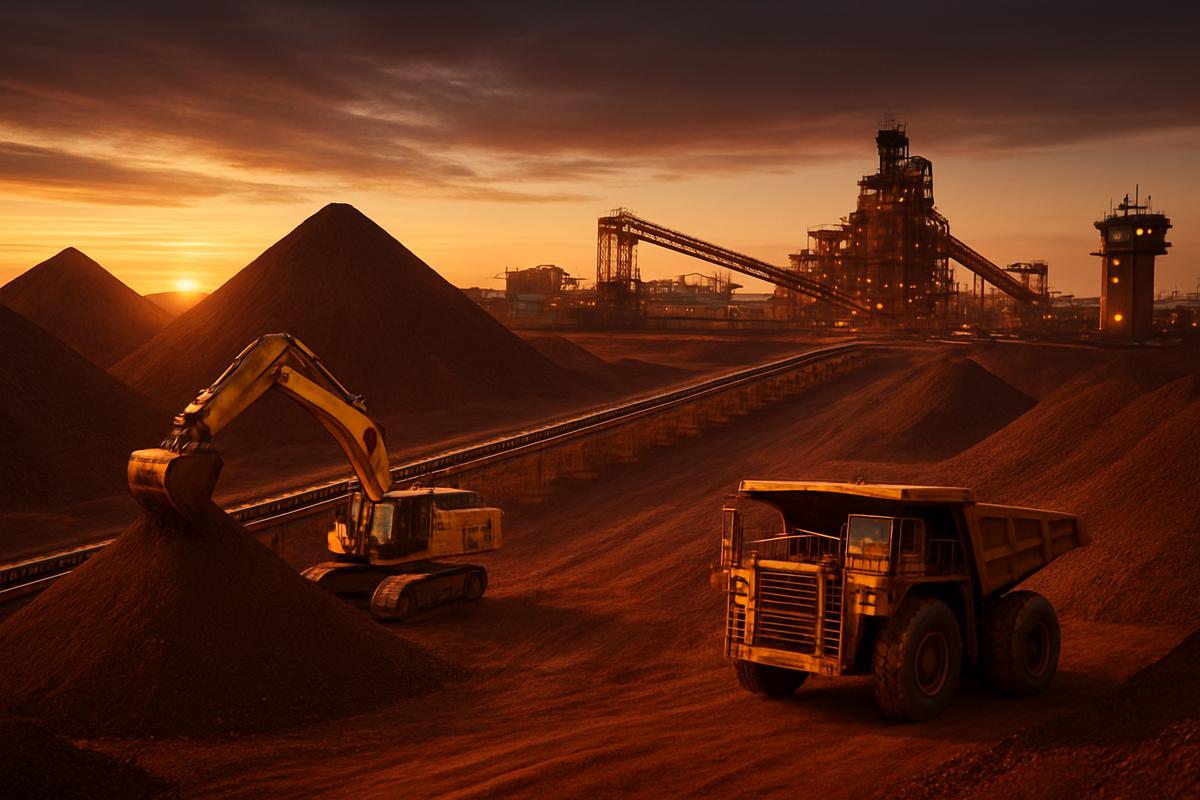
Rio de Janeiro, Brazil – October 28, 2025 – Brazilian mining behemoth Vale S.A. (BVMF: VALE3, NYSE: VALE) is poised to officially reclaim its long-held title as the world's largest iron ore producer, a significant turnaround five years after the devastating Brumadinho dam disaster forced a dramatic reduction in its output. With strong production figures reported throughout 2024 and into 2025, and an annual production forecast of between 325 and 335 million tons for the current year, the company's CEO, Gustavo Pimenta, has expressed confidence that Vale will reassert its leadership, a position it had temporarily ceded to rivals like Rio Tinto (ASX: RIO, LSE: RIO). This resurgence marks a pivotal moment for Vale and signals a recalibration of the global iron ore supply landscape.
This monumental comeback is not merely a statistical achievement but a testament to Vale's extensive operational overhaul and a renewed focus on safety and efficiency. The company's recovery from the 2019 tragedy has been a multi-faceted effort, involving significant investments in dam safety, technological upgrades, and the optimization of its high-quality iron ore deposits. For the broader steel industry, Vale's return to the top promises increased stability in the supply of critical raw materials, particularly the high-grade ore favored by steelmakers striving to reduce their carbon footprint.
Vale's Triumphant Return: A Detailed Look at the Comeback
Vale's journey back to the pinnacle of iron ore production is a narrative of resilience and strategic adaptation. The company, which solidified its position as the world's largest exporter of iron ore as early as 1974, maintained its dominance in production until the tragic events of January 25, 2019. The collapse of the Córrego do Feijão dam in Brumadinho, Minas Gerais, led to a humanitarian and environmental catastrophe, forcing Vale to halt operations at several key mines and drastically cut its iron ore output. This created a vacuum that competitors, notably Rio Tinto, capitalized on, temporarily ascending to the top producer spot.
However, since 2019, Vale has systematically rebuilt its production capacity and reputation. The company implemented stringent new safety protocols, invested heavily in decommissioning upstream tailings dams, and modernized its operational logistics. Key to this recovery has been the record performance at flagship mines like S11D, known for its high-quality iron ore, and a broader improvement in operational reliability across its Brazilian mining operations. By late 2024 and early 2025, Vale's quarterly iron ore outputs had consistently reached their highest levels since before the 2019 disaster, laying the groundwork for the current announcement of its projected return to the number one position. The market's initial reactions have been cautiously optimistic, reflecting an appreciation for Vale's recovery efforts and the potential for a more stable, albeit competitive, iron ore market.
Winners and Losers in a Shifting Landscape
Vale's (BVMF: VALE3, NYSE: VALE) reassertion of its dominance undoubtedly positions the company as a significant winner. Regaining the top spot not only boosts its market share and potential revenues but also restores investor confidence, which had been shaken by the 2019 disaster and subsequent production curtailments. This improved standing could lead to a re-rating of its stock and enhance its access to capital for future growth and sustainability initiatives. Furthermore, steel producers globally, such as ArcelorMittal (NYSE: MT) and major Chinese steel groups like Baowu Steel, could also benefit from Vale's consistent supply of high-grade iron ore, which is crucial for efficient and lower-emission steelmaking processes. A stable and diversified supply chain reduces price volatility and ensures the availability of premium raw materials.
On the other side of the ledger, major competitors like Rio Tinto (ASX: RIO, LSE: RIO) and BHP Group (ASX: BHP, NYSE: BHP) might find themselves in a more intensely competitive environment. While these companies have robust operations and diversified portfolios, Vale's return to the top means a tightening of the market for the coveted number one position. They may need to reassess their growth strategies, focusing on cost efficiencies, further diversification, or niche high-value products to maintain their competitive edge. The shift could lead to strategic adjustments in investment priorities and a renewed push for innovation to differentiate their offerings in a market now dominated by a resurgent Vale.
Broader Significance and Industry Ripple Effects
Vale's regaining of the top spot in iron ore production is more than just a corporate achievement; it carries significant implications for broader industry trends and global economic dynamics. This event underscores the growing importance of high-grade iron ore in the global steel industry, which is increasingly focused on decarbonization. Vale's emphasis on maximizing value from its superior quality ore aligns perfectly with the industry's drive to reduce emissions, as high-grade inputs allow for more efficient blast furnace operations. This trend could accelerate the demand for premium ores and put pressure on producers of lower-grade materials.
The ripple effects extend to the global supply chain, impacting shipping logistics, raw material procurement strategies for steelmakers, and potentially influencing iron ore price benchmarks. A strong Vale ensures a consistent supply from Brazil, balancing the supply from Australia and other regions. Furthermore, the company's post-Brumadinho commitment to enhanced safety and environmental governance could set new benchmarks for the mining industry worldwide. Regulatory bodies globally may look to Vale's implemented safety protocols as a precedent, potentially leading to stricter regulations on tailings dam management and overall operational safety, influencing policy in other mining jurisdictions. Historically, shifts in leadership among major commodity producers often lead to periods of strategic realignment across the industry, with competitors adapting to new market realities and supply dynamics.
What Comes Next: Navigating the Future of Iron Ore
In the short term, the focus for Vale will be on consistently meeting its ambitious 2025 production targets and demonstrating sustained operational reliability. The market will closely watch quarterly production reports and any further updates on its safety and environmental initiatives. This period will also see competitors, particularly Rio Tinto and BHP, recalibrating their strategies in response to Vale's resurgence. Potential strategic pivots could include increased investment in exploration, development of new mining technologies, or a greater emphasis on downstream processing to add value.
Looking further ahead, Vale's long-term strategy will likely involve solidifying its leadership through continued innovation in mining techniques, further optimization of its asset base, and potentially exploring diversification opportunities within the broader metals and mining sector. The global drive towards decarbonization presents both opportunities and challenges; Vale will need to continue investing in sustainable mining practices and potentially explore "green iron" initiatives to maintain its relevance. Market opportunities may emerge for technology providers offering solutions in automation, AI-driven predictive maintenance, and advanced environmental monitoring for the mining sector. Conversely, challenges include navigating geopolitical uncertainties, managing inflationary pressures on operational costs, and adapting to evolving global demand for steel. Potential scenarios range from a stable, competitive oligopoly among the top producers to periods of increased price volatility driven by supply-demand imbalances or unforeseen geopolitical events.
A Resilient Comeback and a Redefined Market
Vale's re-emergence as the world's leading iron ore producer is a powerful narrative of corporate resilience and strategic recovery. It signifies not only a remarkable turnaround from the shadows of a profound tragedy but also a recalibration of power within the global mining industry. The key takeaway is that operational excellence, coupled with an unwavering commitment to safety and sustainability, is paramount for sustained leadership in the commodities market.
Moving forward, the iron ore market is expected to remain highly competitive, with a renewed emphasis on high-grade ore and environmentally responsible mining practices. Investors should closely monitor Vale's (BVMF: VALE3, NYSE: VALE) ability to maintain its production momentum, the strategic responses of its main competitors like Rio Tinto (ASX: RIO, LSE: RIO) and BHP (ASX: BHP, NYSE: BHP), and the overarching trends in global steel demand, particularly from China and emerging economies. The lasting impact of this event will likely be a more scrutinizing approach to ESG (Environmental, Social, and Governance) factors across the mining sector, as companies strive to balance production targets with social license to operate.
This content is intended for informational purposes only and is not financial advice







